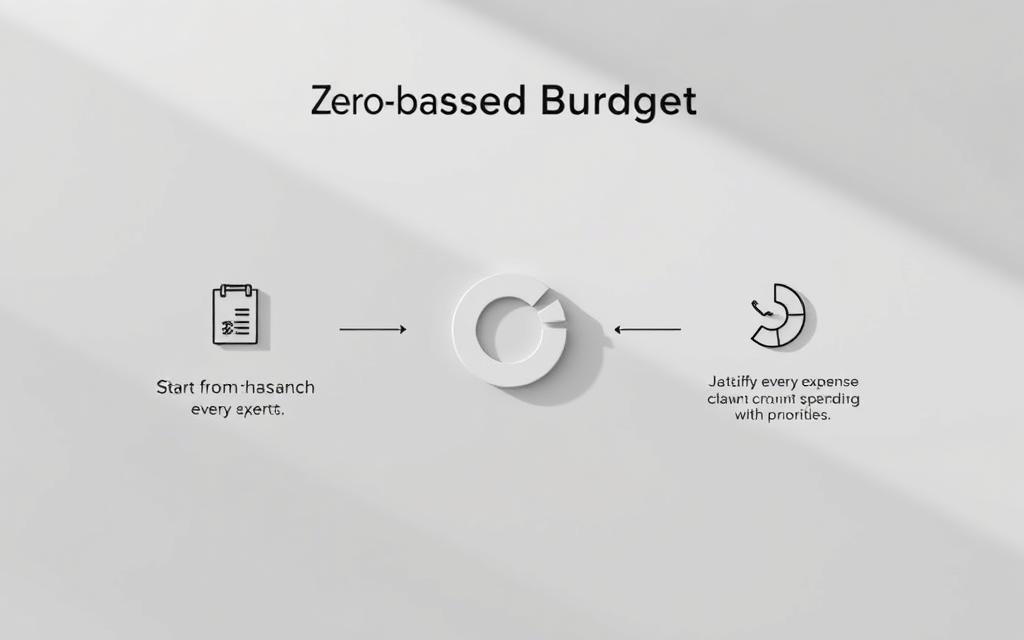Advertisement
Did you know companies can cut costs by up to 30% with Zero-Based Budgeting? This method demands every expense be justified anew each time. It’s a new way to plan finances, starkly different from old methods that use past expenses.
With the economy’s future uncertain, many firms see this budgeting as a key tool. It not only focuses on saving money but also ensures spending meets company goals. Thus, it helps make spending decisions more disciplined. By learning and using Zero-Based Budgeting, companies can better their budget strategies.
What is Zero-Based Budgeting?
Zero-Based Budgeting (ZBB) is all about looking at your budget with fresh eyes each time. Unlike old methods where last year’s budget affects the new one, ZBB starts from scratch. Every cost needs proof that it’s necessary, making sure money is used wisely and keeps the organization on track.
Definition of Zero-Based Budgeting
ZBB means starting at zero for each budget cycle. Every expense must be explained and linked to the organization’s goals. This way, spending focuses on what’s really needed now, not just on what was spent before.
Key Principles of Zero-Based Budgeting
Zero-Based Budgeting stands on a few key rules:
- Starting from a Zero Base: Every time a budget is made, it’s like you’re starting from zero.
- Justification for All Expenses: Every department needs to prove why they need the money they’re asking for.
- Focus on Current Operations: Money goes to what’s needed now, not based on past budgets.
- Engagement Across Management Levels: Everyone from top to bottom is included in making the budget.

This way of budgeting gets everyone involved in financial planning. It makes sure money matches up with what the organization aims to do. By starting from zero every time, it keeps things efficient and accountable.
Benefits of Zero-Based Budgeting
Zero-Based Budgeting (ZBB) helps organizations upgrade their financial habits. By using it, companies can make their budgeting and spending better. They become more efficient at managing resources. The good things about it include more accountability, cost savings, and being more financially smart.
Enhanced Financial Management
ZBB makes managing money better by making sure every dollar is spent wisely. It asks businesses to look closely at each expense. This means they can cut spending that’s not needed. By doing this, companies use their money more wisely. This leads to a strategy that can last a long time.
Greater Accountability
ZBB means more responsibility for everyone involved. Every department must explain why it needs its money. This creates a clear picture of where the money goes. It makes everyone think about how they use resources today and in the future. It leads to smarter decisions about money.
Increased Cost Savings
Companies that use ZBB often save more money. They do this by regularly checking their budgets. This helps them find areas where they can spend less. Focusing on what’s really necessary leads to better control over their budgets. It also encourages new ideas and sets up a stronger base for new projects.

How Zero-Based Budgeting Works
Zero-based budgeting (ZBB) begins every budget with a blank page. It makes companies look closely at their needs. This way, they match their spending with what’s really important now. Knowing how ZBB works is key to using it right.
Step-by-Step Process
To start zero-based budgeting, follow these steps:
- Identify decision units responsible for budget requests.
- Gather detailed data on past and current expenditures.
- Define objectives and priorities for the budget period.
- Create a list of funding requests based on the defined priorities.
- Evaluate and rank each request according to its alignment with strategic goals.
- Allocate funds starting from a zero base, rather than relying on previous budgets.
Comparison to Traditional Budgeting
Zero-based budgeting doesn’t just roll over last year’s budget like traditional budgeting does. It asks for every dollar to be justified again. Traditional methods might keep funding things we don’t need. But ZBB makes us rethink every cost.
This method shakes up how we use our money and holds us accountable. With ZBB, companies can use their funds more wisely. This leads to reaching financial goals.
Preparing for Zero-Based Budgeting
Getting ready for Zero-Based Budgeting is very important. The first steps include careful planning and looking closely at financial data. Gathering a lot of financial details helps organizations know their current money situation. Without this important step, making a budget might not be as thorough as it needs to be.
Gathering Financial Data
Collecting financial data successfully means getting information from different places. This includes predictions about income and past spending habits. This information helps form the core of making a budget. Organizations should make sure to:
- Identify key financial measures
- Get data from various departments
- Check that the data is correct to track expenses well
By carefully organizing this data, companies can find key insights for budgeting. This helps them see where they can save money.
Analyzing Past Expenses
Looking at past expenses is key to getting the most out of Zero-Based Budgeting. Companies should thoroughly check their past spending to find costs that aren’t needed. They should do things like:
- Look at past budget trends
- Find recurring costs that might need another look
- Spot spending that’s different from what was expected
This careful review of spending helps companies make better budget plans. By cutting unnecessary costs, they can use their money more wisely. This ensures future budgets are right for their current financial state, without repeating anything unneeded.
Setting Up a Zero-Based Budget
Creating a Zero-Based Budget (ZBB) involves carefully picking out needed costs that match with a company’s money goals. This step makes sure we know all budget categories well. This helps make sure every dollar spent helps reach the company’s big goals. It’s important to know the difference between fixed and changing costs to properly plan for things like utilities, renting space, paying people, and other costs of running things.
Identifying Required Expenses
To start a zero-based budget right, you first figure out what expenses are a must for the time ahead. This means looking closely at different budget areas and picking out costs vital for keeping things going. Important expenses include:
- Fixed costs like salaries and rent
- Variable costs such as utilities and supplies
- Discretionary spending important for hitting financial goals
This step helps companies ensure every penny spent is necessary. It makes every cost support the main parts of the company and proves its worth.
Allocating Funding
Once you know what you need to spend money on, the next step is allocating funds wisely. This part of budgeting makes it clear funds should go to essential operations. Doing so helps:
- Make departments work better
- Stop wasting money
- Back activities that match financial goals
This way, setting priorities in giving out funds means every area gets enough money to do well. This organized method makes managing resources easier and helps the company perform well in the long term.
Common Misconceptions About Zero-Based Budgeting
Understanding budgeting myths is crucial for proper financial planning. Some think Zero-Based Budgeting (ZBB) is only for big companies. But, small businesses can also gain from ZBB. It helps them track money better and use resources wisely. So, ZBB works well for any size business, not just the big ones.
Many believe ZBB is too hard to start. They think it makes things more complicated. However, with the right tools, ZBB can be simple. There are tools out there that make budgeting easier. This means companies of any skill level can use ZBB effectively.
Challenges of Implementing Zero-Based Budgeting
Implementing Zero-Based Budgeting (ZBB) has its roadblocks. Organizations face the task of overcoming resistance and managing the time it demands. Recognizing these challenges leads to efficient budgeting and successful change.
Resistance to Change
Stakeholders used to traditional budgeting might resist ZBB. They prefer what they know over new methods. To overcome this, organizations need clear communication.
Training and open talks show the benefits of ZBB. A culture open to new ideas and adaptability is key in overcoming resistance.
Time-Consuming Processes
The ZBB process is time-heavy, especially at the start. Companies must work hard to build budgets from zero, analyzing data and working with stakeholders. This can extend beyond what seems manageable.
However, focusing on efficient time management at this stage can make things smoother. The initial effort pays off, leading to better financial outcomes.
Zero-Based Budgeting Tools and Software
Companies wanting to use Zero-Based Budgeting often choose special software. These tools make managing budgets more efficient and effective. They also make it simpler to keep track of and understand financial info. With the best technology for budgeting, businesses can make better decisions and work better together across departments.
Popular Budgeting Applications
Several budgeting apps are popular for businesses using ZBB. Tools like Adaptive Insights, Oracle NetSuite, and Planful are built to meet ZBB’s unique needs. They offer powerful features. These apps help users simplify budgeting, manage money better, and keep things transparent organization-wide.
Features to Look For
When looking for ZBB software, think about must-have features like:
- Customizable templates that fit various budget models.
- Real-time collaboration for better team communication.
- Expense forecasting to estimate future costs.
- Flexible reporting capabilities for insightful financial data analysis.
Choosing financial software with advanced features simplifies reviewing budgeting tools. It makes sure the chosen tools work well with your current financial setups. This enhances the whole budgeting process and aids in superior financial management across the company.
Case Studies: Success Stories
Looking into real-life examples of Zero-Based Budgeting shows many success stories. ZBB success stories prove how effective this method can be. It’s been used by big and small companies to better their finances and sustain their business.
Corporations Thriving with Zero-Based Budgeting
Several big companies have made ZBB a key part of their financial plans. Firms like Kraft Heinz Company and Coca-Cola have seen big cost cuts and better management of resources. These companies have used ZBB to make their operations more efficient and improve their money matters, proving they can handle market challenges and fine-tune their budgets.
Small Businesses Making the Transition
ZBB is also very helpful for small businesses. Many examples show how local shops have adopted ZBB and seen benefits. They have better control over their cash flow and know how to focus on important spending. ZBB helps small companies stay strong, even when the economy changes. Stories from real businesses show how ZBB can greatly improve a company’s financial health.
Tips for Successful Zero-Based Budgeting
To get good results with Zero-Based Budgeting, companies should always check and adjust their finances. Checking the budget often helps make sure money is spent right, matching company goals. Being able to change the budget when needed, based on the latest financial information, is key.
It’s crucial to talk well between departments in this budgeting method. Working together across departments ensures everyone is clear and responsible. When everyone involved in finances talks together, it helps match the financial plans with what the team thinks is most important.
- Conduct budgeting reviews frequently to adapt to changing conditions.
- Establish a framework for interdepartmental communication to enhance collaboration.
- Encourage team finance discussions to promote a unified approach.
Conclusion: Is Zero-Based Budgeting Right for You?
When organizations look at their finances, they must review if Zero-Based Budgeting (ZBB) fits. They should consider their operations’ complexity, size, and financial goals. Before shifting to ZBB, it’s key for groups to check if this budget method works for them.
Factors to Consider
It’s essential to know if your group can set aside resources for budgeting. Looking over your budget strategies helps see if ZBB aligns with your goals. This also promotes better cost management and responsibility.
Final Thoughts on Budgeting Strategies
Zero-Based Budgeting can deeply impact how a business plans its finances. It helps organizations take on financial issues with more confidence. A good budgeting technique improves how a business runs and helps everyone understand money better.



